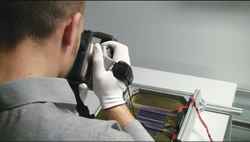
Posted to News on 2nd Sep 2013, 17:27
Thermal imaging for the full life cycle of a solar module
FLIR thermal imaging is increasingly playing an important part in ensuring maximum energy yield from solar panels. It is involved throughout the life cycle of the product from its design, manufacture and quality assurance procedures through to installation and ongoing maintenance. No other technology has its scope of application.

Solar technology is a long-term investment with a payback period of typically 11 to 13 years depending on the initial purchase price, changing energy costs and, of course, the amount of sunlight to which it is exposed.
Oliver Frank, Team Manager R&D at Solon, a globally active solar system supplier, explains: "We design our modules to operate for at least 30 to 40 years and more. We don't manufacture our own solar cells so strict quality controls are a necessity to ensure they live up to the high standards we have set ourselves. And for this our FLIR P-Series camera is crucial, particularly for shunt detection."
Shunts can heavily reduce the solar cell's conversion efficiency and the cause is generally manufacturing defect rather than poor solar cell design. Low shunt resistance causes power losses by providing an alternate current path for the light-generated current, and the effect of this is particularly acute at low light levels.
To detect shunts in its solar cells before lamination Solon engineers apply a reverse bias to a single cell to minimise charge flow and use the FLIR camera to look at the thermal pattern. Oliver Frank adds: "Hot spots indicate local shunts due to manufacturing flaws in cell's semiconductor material. Quite simply this test allows us to make sure the quality of the cell is above a certain grade."
Based on the success of FLIR thermal imaging in its R&D department, Solon selected two of the company's T-Series cameras for field inspection. These cameras are optimally designed for predictive maintenance applications. They are lightweight, compact and characterised by their tiltable optical unit that makes them highly ergonomic.
Volker Denzler, a Solon thermographer, explains: "We use the FLIR T-Series cameras to check solar power plant before handover to the customer and also for post installation monitoring and maintenance services.
"The cameras are a wonderful addition to our field inspection methods. Before, we had to measure each string by hand which was very time consuming, especially in large installations. And even when we found a defective string, determining the exact cell or cells that were the cause of the problem was a matter of guesswork. With the FLIR camera we can pinpoint the problem and see the cause."
Common problems
Usually thermal anomalies indicate loss of yield from the solar module in question, and in some cases hot spots confirm such high temperatures that they are considered a fire risk. More often, however, the cause is connection issues, which are easily resolved. Cell damage, breakage in the protective glass layer, defective bypass diodes and shadowing are other common defects that Solon seeks out with thermal imaging.
Volker Denzler adds: "A FLIR thermal camera is the best tool available to find out what's wrong and why a module shows a decrease in yield. It is especially valuable for detecting bypass diodes that have become defective as the result of a thunderstorm, for example. These used to be very difficult to identify but such problems show up very clearly on the thermal image."
As well as the inspection of individual modules, the FLIR T-Series cameras are used to check the entire installation including cables, connectors, fuse boxes and inverters. And for Solon the tiltable lens unit is especially useful.
Volker Denzler explains: "When we're inspecting a module in the field we usually try to look at the back, if the installation permits." This method avoids the solar reflection problems that can skew measurement results when imaging the module from its highly reflective front. "With the tiltable lens unit we can easily capture the back of the module without having to crawl on the ground. It allows us to point the camera from every possible angle."
Instant reporting
The FLIR T-Series cameras come complete with various standard features that are proving valuable to Solon. Thermal Fusion - that combines both visual and thermal images - and Instant Report are particular favourites. Instant reporting allows Solon engineers to show their preliminary findings to the plant manager, on site. And this initial report is always followed up by a more detailed document prepared using FLIR Reporter software.
Volker Denzel continues: "The Reporter software allows us to adjust level and span to show the relevant temperature differences. And because it is Microsoft Word compatible it allows us to create reports easily using Microsoft Office Word. The combination of good service, excellent training and of course unparalleled thermal imaging camera quality makes FLIR Systems a perfect partner for us."
Please visit www.flir.com to learn more about thermal imaging of solar panels.
Want the latest machine building news straight to your inbox? Become a MachineBuilding member for free today >>

















